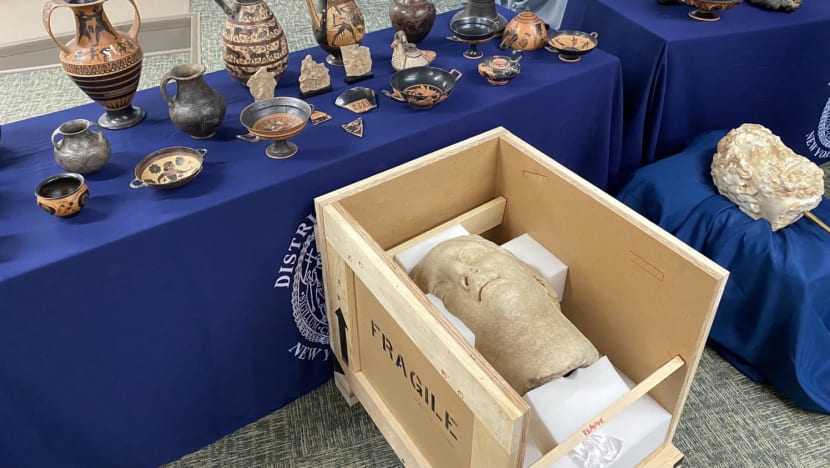Commentary: Museums need to be wary they don’t fuel black market for illicit cultural objects
By acquiring artefacts with unclear provenance, museums and collectors are directly supporting the illicit trade of cultural objects or blood antiquities, says Museum Studies' lecturer Cai Yunci.

The US returned 58 antiquities - 21 of which were seized from the Metropolitan Museum of Art - to Italy on Sep 6, 2022. (Photo: Twitter/HSI New York)
LEICESTER: When you visit a museum, what goes through your mind? Do you simply admire the objects on display? Or do you stop to think where the hundreds of years old artefacts came from and how they were acquired?
On Tuesday (Sep 6), the Manhattan District Attorney's Office announced the return of 58 stolen antiquities worth an estimated US$19 million (S$26.7 million) to Italy. Twenty-one of the pieces, including the Marble Head of Athena, were seized from the Metropolitan Museum of Art.
In Singapore, reports emerged in August that a 386-year-old religious artefact allegedly stolen from Nepal was in the possession of the Asian Civilisations Museum (ACM) in Singapore. The reports alleged that the gold-copper statue depicting a Hindu deity was originally from the Neel Barahi temple and was stolen in 1999 from the house of a caretaker.
ACM said in response to media queries that the item was acquired in 2015 in accordance with the National Heritage Board’s established procedures on acquisition. It added that the item was not listed in the Art Loss Register, the world’s largest private database of looted art.
This is not the first time the ACM has been embroiled in controversy over allegedly illicitly trafficked artefacts.
In 2015, ACM returned a 11th-century Chola bronze sculpture allegedly stolen from India, to the Indian authorities. ACM had purchased the sculpture - depicting a Hindu goddess - in 2007 for US$650,000 from a defunct New York gallery accused of an extensive antiquities-smuggling operation masterminded by the now disgraced art dealer Subhash Kapoor.
PROVENANCE CHECKS
The International Council of Museums (ICOM), which represents more than 40,000 museums in over 141 countries, prescribes strict ethical code of conduct against the acquisition of stolen or illicit artefacts.
The ICOM code of ethics for museums stipulates that museums should exercise due diligence by establishing the full history of the object since its discovery or production prior to its acquisition, and that museums should not support the illicit traffic or market in natural and cultural property, directly or indirectly.
There are established guidelines on how museums should undertake proper due diligence and provenance checks to ensure their acquisitions are ethically and legally sound.
A key criterion is the 1970 threshold established by UNESCO to combat the illicit import, export, and transfer of cultural property.
What this means is that museums should not make the acquisition unless there is documentary evidence that the object left the country of origin before 1970 or has evidence that the object has left legally after 1970.
While museums should consult the ICOM’s Red Lists of Cultural Objects at Risk database and the Art Loss Register, it is widely accepted that these lists are not comprehensive and even if the slated object is not found on these lists, they should be backed by additional provenance checks in other areas.
Related:
Fake documentation is also rife, and museums should exercise extreme caution in assessing the documentary evidence. A general rule of thumb is that museums should not proceed with the acquisition if there is any suspicion about the object.
Museums should also avoid collecting cultural objects from conflict zones (such as Afghanistan, Syria, Pakistan, Yemen, Iraq) as well as regions with a known risk of illicit trafficking in cultural objects (such as China, India, Nepal, Cambodia, Thailand, Indonesia).
Disputes and claims for repatriation or restitution can occur when museums do not carry out their due diligence and provenance checks properly or choose to take a cavalier attitude towards object provenance when presented with incomplete or suspicious evidence about the history of the item.
HUGE PROFITS CAN FUEL BLACK MARKET FOR ILLICIT CULTURAL OBJECTS
There are many good reasons why museums should not acquire objects with unclear provenance. One is the risk of fuelling the development of a black market for illicit cultural objects and exacerbating the looting of such artefacts from their countries of origin.
The illicit antiquities trade operates through same transnational networks of organised crimes, illegal arms trade, and money laundering.
In conflict zones, the trafficking of illicit antiquities contributes directly to the funding of terrorism and hence, these objects are sometimes termed as blood antiquities.
The illegal excavations of cultural materials from archaeological sites not only lead to the destruction of archaeological sites, but also contribute to the loss of the archaeological contexts for these objects, depriving us of the opportunity to develop our knowledge and scholarship about these cultural sites and objects.
While some institutions and collectors have claimed that they are protecting these cultural objects from destruction by collecting them, this line of argument does not make sense.
The only reason why cultural objects continue to be looted from their countries of origin is the huge profits to be made through the illicit art and antiquities trade.
If museums and collectors stop demanding such cultural objects, there will be no incentive for looters and art smugglers to engage in such destructive practices since there is no profit to be made.
By acquiring artefacts with unclear provenance, museums and collectors are directly supporting the illicit trade of cultural objects or blood antiquities.
Museums that engage in trafficking of illicit objects will suffer from significant reputation risks. There will also be a financial loss to museums, as it is unlikely for museums to recover any costs expended on these illicit objects when they are repatriated back to the countries of origin.
Many museums are funded with taxpayers’ money and donations and there needs to be greater accountability over the use of public funds. The best way to do so is for our museums to exercise due diligence on their acquisition process, and to avoid acquiring objects that may be illegally trafficked.
Related:
WHAT CAN MUSEUMS DO TO MAKE SURE THEIR EXHIBITS DO NOT FUEL TRAFFICKING OF CULTURAL MATERIALS?
While law enforcement and seizures of illicitly trafficked cultural objects have stepped up over the years, it is widely accepted that what we know about the illicit trade in art and antiquities is just the tip of the iceberg.
This is because other enterprising traffickers will step in to fill the gap as long as there is demand for these objects from museums and collectors. The only way to effect a substantive change to the illicit trafficking of cultural materials is at the end market, where the purchases of these illicit artefacts take place.
Therefore, it is important that museums and collectors carry out proper due diligence on the provenance of cultural objects prior to acquisition, and they should not acquire objects with unclear provenance especially from conflict zones or areas with a known risk of illicit trafficking in cultural objects.
With greater awareness of the issue of illicit trafficking through several high-profile court cases (such as the disgraced art dealer Subhash Kapoor and art collector Douglas Latchford), as well as greater scholarly interest and discussions on museum ethics and restitution, it is likely that museums which have been acquiring looted objects will continue to face requests for repatriation.
Dr Cai Yunci is Lecturer in Museum Studies at the School of Museum Studies, University of Leicester.
















